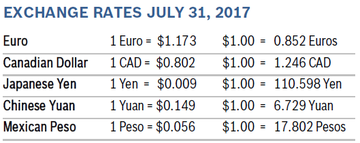|
Market Watch July 31, 2017 All three indexes posted gains for the month, with the DOW closing at a new record high on the 31st. The markets shrugged off the latest rounds of upheaval in the Trump administration as well as concerns over North Korea, focusing instead on good corporate earnings and solid GDP. The DOW rose 2.5% in July to close at 21,891, the tech-heavy NASDAQ rose 3.4% to close at 6,348 and the S&P, the index most closely followed by economists, rose 1.9% for the month, closing at 2,470. Consumer Confidence rises to 121.1 The New York-based Conference Board's Consumer Confidence Index rose to 121.1 in July after June’s reading was revised to show a slight decline to 117.3. The Present Situation Index continued to climb, rising to a 16-year high of 147.8 from a downwardly revised 143.9. The Expectations Index rose to 103.3 from a downwardly revised 99.6 in June. The Expectations Index is typically the most volatile of all the components. The Conference Board said that most consumers expect the economic expansion to continue into the second half of the year. Economists say a level of 90 indicates that the economy is on solid footing and a level of 100 or more indicates growth. Analysts caution that the real driver behind consumer spending is income growth and that labor market trends are a more accurate predictor of consumer behavior. Consumer spending rises 0.1% Consumer spending inched up 0.1% in June after rising an upwardly revised 0.2% in May. It was the weakest showing since spending increased a similar 0.1% in February. The personal consumption expenditures index (PCE) was flat in June after falling 0.1% in May and was up 1.4% year over year. It was the smallest 12-month gain since last September and showed that inflation is continuing to fall farther from the Fed’s target of 2%. Income growth slowed because of declines in dividend and interest payments and other investment income. The key category of wages and salaries actually rose a solid 0.4% in June, reflecting strong employment growth during the month. The personal savings rate slipped to 3.8% of after-tax income, down from 3.9% in May. Consumer spending is closely watched by economists because it accounts for 70% of U.S. economic activity. Consumer Prices Unchanged The Consumer Price Index (CPI) was unchanged in June after falling 0.1% in May. The CPI was up 1.9% from June 2016, the third consecutive month in which year-over-year gains have eased. Core inflation, which excludes food and energy, rose 0.1% for the third consecutive month and was up 1.6% year over year. Core inflation has consistently been below the Fed’s target of 2%. Fed Chairman Janet Yellen told Congress that the Fed believes that the recent lower readings on inflation are partly the result of a few unusual reductions in certain categories of prices. Unemployment Falls to 4.3% The unemployment rate fell to a 16-year low of 4.3% in July and the economy added 209,000 new jobs, above expectations of 180,000. It was the second consecutive month of robust job growth and underscored the resilience of the economy. However, growth in paychecks remains stubbornly slow. Average hourly pay rose 2.5% from July 2016, well below the 3.5% to 4% rate that is typical when the unemployment rate is this low. Hiring in construction has averaged 9,000 per month over the past three months. Fed Chair Janet Yellen has said that the economy needs to create just under 100,000 jobs a month to keep up with growth in the working-age population. Fed Chair Janet Yellen has said that the economy needs to create just under 100,000 jobs a month to keep up with growth in the working-age population. Durable Goods ORDERS Jump 6.5% Durable goods orders jumped 6.5% in June after falling 1.1% in May. The big jump was primarily due to civilian aircraft orders more than doubling from May. Orders for machinery and primary and fabricated metals were also all positive. Shipments of non-defense capital goods excluding aircraft, which factor into GDP, rose 0.2%, slightly below expectations. Orders of core capital goods fell 0.1% in June, but figures for May were revised up to a 0.7% increase from the 0.2% initially reported. The durable goods report is often both volatile and subject to sharp revisions. Chicago PMI drops to 58.9 The Chicago Purchasing Managers’ Index (PMI) dropped to 58.9 in July after surging to 65.7 in June, ending five consecutive monthly increases in the index. Despite the retreat, all components remained above their respective 12-month averages. New Orders fell by 11.6 points to 60.3, the lowest level since February. Production fell 6.9 points to 60.8, the lowest level since April. Order Backlogs dropped 4.9 points from June’s 23-year high to 57.9 in July. Prices Paid rose 3.4 points to 60.9, the highest level in three months. MNI Indicators said that despite the retreat, key indicators remain high and point to robust business confidence. More than 70% of PMI panelists answering the month’s special question reported that they had increased employees’ wages over the past year. Wholesale Prices rise 0.1% The Producer Price Index (PPI) rose 0.1% in June after remaining flat in May and was up 2.0% over the past twelve months. Energy prices fell 0.5% in June, reflecting lower costs of natural gas and gasoline, as crude oil prices have headed down. Core inflation, which excludes volatile food, energy and trade services prices, rose 0.2% in June after falling 0.1% in May and was up 2.0% from May 2016. The PPI for inputs to construction was up 3.2% year over year. Analysts note that prices further back in the pipeline are mixed and expect inflation to remain tame for the foreseeable future. Q2 GDP Rises 2.6% GDP grew 2.6% in the second quarter, slightly below expectations of 2.7% growth, but up substantially from 1.4% growth in the first quarter, according to the Commerce Department’s first estimate. Consumer spending rose 2.8% for the quarter, an improvement from 1.9% in the first quarter. Consumers spent more on both goods and services, a possible reflection of improving consumer confidence and a more positive outlook for the economy. Business spending remained strong, with corporate spending on nonresidential fixed investment rising 5.2%. Although a decline from the first quarter’s 7.2%, it was still one of the best readings since 2014. U.S. exports expanded faster than imports, so trade made a small contribution to growth. Government spending rose, led by a big jump in federal military spending. State and local government spending fell. Spending on home building and improvements was the biggest drag on GDP for the quarter, with residential fixed investment falling 6.8%, the sharpest decline since 2010. A small decline in business inventories shaved 0.02% off GDP. Inflation eased, with the price index for personal consumption expenditures (PCE), the Fed’s preferred inflation gauge, rising 0.3%. Core prices, which exclude volatile food and energy costs, rose 0.9%. Job openings Fall The number of job openings fell by 301,000 in May after rising to the second-highest level on record in April, which was revised down slightly to 5.97 million from 6.04 million, according to the latest Jobs Openings and Labor Turnover Survey (JOLTS). Every industry except arts & entertainment saw hiring increase in May. Quits rose across all industries and the quits rate returned to its cycle-high of 2.2% after falling in April. Coupled with increased hiring across almost all sectors, the broad-based increase in the quits rate should indicate wage gains ahead. For most of JOLTS history, the number of hires has exceeded the number of job openings, but since January 2015 this relationship has reversed, with job openings outnumbering hires in most months. A rising quits rate generally leads to faster wage growth. The JOLTS report is one of Fed Chair Janet Yellen’s preferred economic indicators. Fed Leaves interest rates unchanged The Federal Reserve kept interest rates unchanged in a range of 1.0% to 1.25% when the Open Market Committee met in July. The Fed expects to start winding down its massive holdings of bonds "relatively soon," which is a sign of confidence in the U.S. economy. Looking ahead, the FOMC sees inflation remaining somewhat below 2% in the near term, but eventually stabilizing around 2%. © Robert Bosch Tool Corporation. All rights reserved, no copying or reproducing is permitted without prior written approval.
Comments are closed.
|
|








